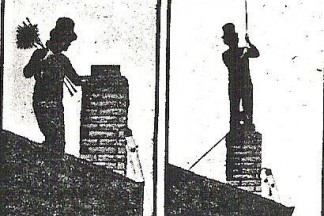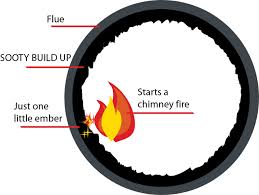Wood heaters are much maligned these days, accused unfairly of contributing to our pollution levels. All wood-stoves bought today have to pass stringent tests to comply with the Australian Standards. What isn’t so better known is that you need to burn your fuel properly to cut down any emissions. If you see excessive smoke coming from your flue or chimney, then you may not be burning the fuel correctly. It’s important to burn your fuel efficiently for many reasons, greenhouse gasses, global warming, and the cost of your fuel. The harmful behavior of those who burn wood badly has led to continual attacks in the media on the whole idea of residential wood heating.
Your flue system is an integral part of your heating system and needs to be checked and cleaned yearly. A good time to do this is before the cold weather sets in and you need the fireplace. If your fire has been burning too slow, creosote builds up and can choke a flue causing the heater to be difficult to start and smoke will enter the room when the heater door is opened. Inefficient burning can also lead to a fire with the flue itself. Flue lengh is also important to how your heater performs. If the length isn’t long enough, it will not draw sufficient air for proper combustion of the fuel
Flue Care & How to Burn Your Fuel Efficiently
There are other reasons why your fire may be producing too much smoke, and I have listed some of them here with ways to remedy the problems:
- insufficient kindling being used when starting. – Use plenty to establish a good fire quickly, when lighting a cold heater
- too much firewood in the heater – Will not allow air to circulate, so stack the wood loosely
- turning the air control to slow burn too soon after light-up or refuelling – Open the air controls fully for 5 minutes before and 15–20 minutes after reloading
- don’t try to burn a single large log
- adding firewood without opening the air control – will cause smoke in the room
- an incorrectly placed log which blocks the air supply to the base of the fire
- use of wood that is too wet – unseasoned wood has more moisture which makes a heater smoke, freshly cut wood needs to be stored for 8 – 12 months under cover in a dry ventilated area.
Last but not Least:
It is universally recommended that flue systems be cleaned and inspected once a year. Check your chimney regularly whilst using – if there is smoke coming from the chimney, increase the air supply to your fire. Once you’ve been heating this way for a while you will know where the optimum settings for your heater are. If buying a new wood heater, check the compliance plate on the back to make sure it meets the current Australian Standard (AS/NZS4013:1999).
For further reading – Anatomy of a flue fire: http://www.woodheat.com.au/chimFire.html
Clear up some misconceptions about wood heating: http://www.woodheat.org/



